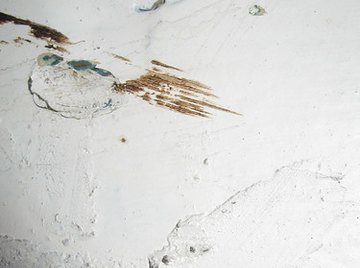
Also known as saltpeter, potassium nitrate is a white crystallized compound composed of potassium, nitrogen and oxygen. Most commonly used in fireworks, matches and fertilizer, its medical applications include diuretics to reduce high blood pressure. Although typically produced synthetically, mining continues of the natural mineral, which has significant commercial value.
History and Use
The use of potassium nitrate goes back to the early Romans and Greeks, who used saltpeter to fertilize their plants. In the third century B.C., the Chinese learned that a mixture of charcoal, sulfur and potassium nitrate could create an explosive powder. Since the Middle Ages, it has played a role in preserving meat and tanning hides, as well as glass production and metalworking. Modern uses include gunpowder, food preservatives, various crafts and to lessen angina pain in heart patients.
Formation
Potassium nitrate forms naturally in warm climates. Bacteria from the decomposition of feces, urine and plants combine with air, moisture, plant ash and alkaline soil to create nitrification—the conversion of the decaying matter into nitrates that penetrate the soil. Dissolved by rainwater, the evaporated deposits form a white powder. Once boiling and evaporating wash impurities away, potassium nitrate is ready for practical uses.
Cave Deposits
In the early part of the 19th century and throughout the Civil War, caves in many Southern states were rich sources of potassium nitrate. Usually found as huge crusts and growths on cave walls and ceilings, they formed when solutions containing alkali potassium and nitrate seeped into cavern cracks and crevices. For example, the DesertUSA website reports that miners extracted 200 tons of potassium nitrate from Mammoth Cave in Kentucky between 1811 and 1814, to use in the making of gunpowder.
Desert Sources
A major source of potassium nitrate was the Atacama Desert in Chile—“the driest place on Earth,” according to National Geographic. More than 170 mining towns were in full operation up until the early 1940s to supply the world with potassium nitrate. Since the invention of synthetic nitrate, however, they have all but shut down.
Potential Dangers
The International Programme on Chemical Safety (IPCS) website states that breathing potassium nitrate can cause coughing and sore throat, and contact with the eyes or skin can cause redness and pain. People exposed to the chemical should remove any contaminated clothing, and flush the area with clean water and soap. Proper protection when working with potassium nitrate includes gloves, mask and protective goggles to avoid contact and inhalation. Unless directed by a physician, avoid taking potassium nitrate internally. According to the IPCS, it can cause abdominal pain, dizziness, labored breathing, confusion, headache and nausea.
References
About the Author
Kelly Wallace has been a full-time writer for more than 15 years, specializing in health, education, spirituality and marketing. She is the bestselling author of several novels and nonfiction self-help books, as well as a freelance writer, blogger, publicist and radio show host. Wallace also served as the marketing director and radio manager for a major publishing company.
Photo Credits
Image by Flickr.com, courtesy of Sherrie Thai
